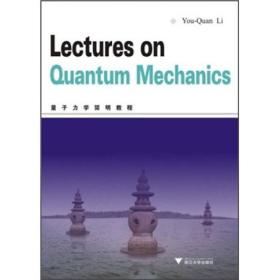
量子力学简明教程
全新正版 极速发货
¥ 24.9 6.6折 ¥ 38 全新
库存2件
浙江嘉兴
认证卖家担保交易快速发货售后保障
作者李有泉
出版社浙江大学
ISBN9787308079846
出版时间2010-12
装帧其他
开本其他
定价38元
货号1895239
上书时间2024-11-04
- 最新上架
商品详情
- 品相描述:全新
- 商品描述
-
导语摘要
Thisisbasedontheauthor'sfollowingtwoprinciples:(i)ifatextbookweresoperfectlyarrangedthatleavesnothingtobedesired,itwouldmakethereadersfeelthatthescientificdiscoveryissomysticalthattheylosepassionofcreativity;(ii)ifacourseweresopurelypresentedthathighesonaperfectaxiomaticswithoutmentionofincompletedoctrineinhistoryofscience,itwouldlosethechanceoftrainingstudents'powerofcreativity.Collegestudentsshouldcultivatetheirabilityofcapturingknowledgeandattainthepowerofemployingknowledgeinadditiontothesimpletaskofabsorbingknowl-edge.Sotheauthortriedtoadoptsecond-personpronouninpresentingthiscourse.Accordingtotheauthor'steachingexperience,somemediatestepsofmathematicalformulationthatbeginnersarenotabletofigureoutfrequently,arealsogiven.Inordertoavoidtoomuchcontentinclass,someimportantexamplesarearrangedasproblemswithsolutions.
目录
I Basic Concepts and Main Applications
1 The Discovery of Quantum Theory
1.1 Blackbody Radiation and Planck's Hypothesis of Energy Quanta
1.2 Photoelectric Effect and Einstein's Hypothesis of Light Quanta
1.3 The Atomic Spectra and Bohr's Model of Atoms
2 Wavefunction and Schr6dinger Equation
2.1 The de Broglie Hypothesis and Davisson-Germer Experiment
2.2 Schrodinger Equation
2.3 Stationary Solutions
2.4 General Properties of Motion in One Dimension
2.5 Bound States in Potential Well
2.5.1 Square Well of Infinite Depth
2.5.2 Square Well of Finite Depth
2.6 The Harmonic Oscillator
2.7 Tunnelling Effect
3 Operators and Heisenberg Uncertainty Relation
3.1 Observables and Operators
3.2 Hermitian Operators and Their Properties
3.3 Some Example Operators
3.3.1 Momentum Operators and Their Eigenfunctions
3.3.2 Angular Momentum Operators and Their Eigenfunctions
3.3.3 Coordinate Representation and Momentum Representation
3.4 Evaluation of the Expectation Values
3.5 The Heisenberg Uncertainty Relation
3.5.1 Commutation Relations and Their Implications
3.5.2 Uncertainty Relation and the Minimum Uncertainty State
3.6 The Time Evolution of Expectation Values
4 Motion in a Centrally Symmetric Field
4.1 Three Dimensional Harmonic Oscillators
4.2 The Feature of Motion in a Centrally Symmetric Field
4.3 Spherical Waves and Plane Waves
4.4 Motion in a Coulomb Field
4.5 Hydrogen-like Energy Levels
4.6 Hydrogen Atom and Hydrogen-like Ions
5 States and Heisenberg Equation
5.1 Matrix Representation of Operators
5.2 States and Their Representations
5.3 The Heisenberg Equation
5.4 Algebraic Approach for Harmonic Oscillator
5.5 Algebraic Approach for Angular Momentum
II Developing Skills
6 Bound-State Perturbation and Corrections to Energy Levels
6.1 Nondegenerate Perturbation TheOry
6.2 Degenerate Perturbation Theory
6.3 Stark Effect
7 Time-dependent Perturbation and Quantum Transitions
7.1 Perturbation Depending on Time
7.2 Transition Probability
7.2.1 Periodic Perturbation of Single Frequency
7.2.2 Transition to Continuous Spectrum
7.3 Induced Absorption and Emission
7.4 Einstein's Semi-phenomenological Theory for Spontaneous Emission
8 Scattering Theory for Elastic Collisions
8.1 Scattering Amplitude and Cross Section
8.2 Born Approximation
8.2.1 The Simplest Approach
8.2.2 Lippmann-Schwinger Equation
8.2.3 Scattering by Screened Coulomb Potential
8.3 Partial-Wave Approach
8.3.1 Phase Shifts and Scattering Amplitudes for Centrally Symmetric Potentials
8.3.2 Neutron-Proton Scattering
8.3.3 The Center-of-Mass Frame and the Lab Frame
9 Motion in a Magnetic Field
9.1 Schrodinger Equation for a Charged Particle in Electromagnetic Fields
9.2 Electrons in a Uniform Magnetic Field
9.3 Atoms in Magnetic Field and Zeeman Effect
9.4 Electron Spin
9.5 Spin-Orbit Coupling and the Fine Structure of Atomic Spectra
9.5.1 On Spin-Orbit Coupling
9.5.2 On the Fine Structure of Atomic Spectra
10 Identical Particles and Pauli Exclusive Principle
10.1 Permutation Symmetry and the Indistinguishability of Identical Particles
10.2 Noninteracting Systems, Pauli Exclusive Principle
10.2.1 Two-particle Systems
10.2.2 N-particle Systems
10.3 Interacting Systems
10.3.1 Helium Atom, Hund's Rule
A Matrix and Vector Space
B δ-function
C Confluent Hypergeometric Function
D Orbitals for d-Electrons
E Lab Frame and Center-of-mass Frame
F On an Integral
G Time Reversal and Kramers Degeneracy
相关推荐
— 没有更多了 —



















以下为对购买帮助不大的评价